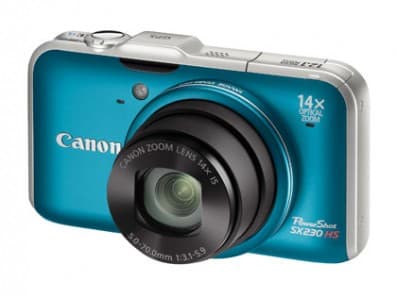Providing a long zoom in a small body, while also offering creative controls, is a tough thing to ask, but this is what is now demanded of a travel compact camera. Canon’s PowerShot range includes the company’s more creative compact models, such as the G12 and SLR-style SX30 IS. The SX230 HS sits just below these models and, like the S95, features the HS system for lower noise at high ISO, combining a high-sensitivity sensor and the Digic 4 processor.
Features and build
The camera’s HS sensor is a 12.1-million-pixel, 1/2.3in CMOS device delivering a 4000×3000-pixel image, purely as a JPEG in fine or normal compression. The lack of a raw option is a shame.
Sensitivity runs from ISO 100-3200, while the low-light scene mode allows up to ISO 6400 at 3 million pixels, which, given the downsizing, surely could have been pushed to ISO 12,800 or ISO 25,600. The lens gives a 14x zoom, ranging from 28-392mm (equivalent) with a maximum aperture of f/3.1-5.9.
The wideangle setting is limited compared to the 24mm offered by much of its competition, but, pleasingly, aperture selection can be selected in 1⁄3 stops, although only to f/8 even at its most extreme, leaving just a 2⁄3 stop between maximum and minimum apertures.
Metering offers a choice of evaluative, centreweighted or spot options, but where it gets interesting is in the choice offered by the focus. For single-point focus, only a central AF point can be selected, with other options available for face detection and AF tracking.
The size of the AF point can be changed between normal and small for more accurate selection, but the subject must be locked on in the centre and recomposed. This seems unusual, but on such a small camera it is probably faster than trying to adjust the focus point to the right area. Manual focusing is available using the rear control wheel for adjustment and a magnified central window to check focus.
Servo focusing is possible with continuous focus when the shutter is half pressed, but continuous focusing can be achieved without the shutter button being pressed – as with a video camera – which should help speed up the final focusing time. Continuous shooting is available at 3.2fps and, in the high-speed scene mode, can maintain an 8.1fps burst at 3 million pixels.
Shooting modes include manual, aperture and shutter priority, program, auto and a range of scene modes. Video capture is available in full HD (1080p) at 24fps and saved in QuickTime MOV format. The mode dial also features a dedicated super-slow-motion video mode at 640×480 pixels (120fps) or 320×240 pixels (240fps).
The camera includes an integrated flash and a GPS receiver. An SX220HS model is also available without the GPS, but with otherwise identical specification. Although the rear of the body is dominated by the 3in, 461,000-dot LCD screen, the SLR-style shooting mode dial and rotating multi-controller button make operation simple. The control wheel isn’t marked with its quick functions and they only display on the screen when the camera is first turned on, which means picking the right control often takes a bit of guesswork.
Performance and image quality
The autofocus system is fast and effective, and is aided by a strong AF illuminating lamp for low light. Images from the SX230 HS are bright and punchy, with a crisp sharpness, suggesting serious in-camera processing.
The evaluative metering performs very well, leaving an evenly distributed range of tones, although highlights are often clipped slightly to the general benefit of the scene. Those who prefer to keep these can easily reduce the exposure compensation by 1⁄3 stop.
My Colour mode provides a range of options to boost the colours further via vivid, tone them down with neutral or use one of the other nine settings, including b&w. On our resolution chart at base ISO 100, the camera recorded up to 22.
The HS system does a good job of maintaining a reasonably high level of detail until ISO 1600, but showed significant fall-off at ISO 3200. Noise reduction is also present in scenes from ISO 400, although in our portrait shots taken at ISO 800 the images remain smooth and detailed.

Image: Even in portraits taken in low light at ISO 800, noise is well controlled
Verdict
This is a practical and affordable travel compact with plenty of features to keep the more advanced user occupied.
It would be nice to see a more extensive aperture range, greater ISO span and performance, as well as the inclusion of raw capture but, as pocket compacts go, the Canon PowerShot SX230 HS is a sound choice.







